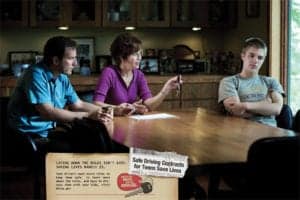
Teens behind the wheel!
It’s amazing, but somehow that Little you just brought home for the first time yesterday is now not so much a Little, but is ready to be behind the wheel. It’s an exciting time. For the parent, it’s another set of wheels in the house to run errands and drive around younger siblings. For the teen, it means freedom.
But it also means that a young adult with no experience is now the operator of a two ton death vehicle. Suddenly, enjoyment is replaced with apprehension. Is today the day you’ll get the call your teen did something that you or another family will have to live with for the rest of your lives?
How can you help guide your teen down this exciting and very scary time? There are things you can do to help them, and the better prepared they are and the more aware they are, the more likely they are to be safe drivers.
Talk to Them

Setting expectations with your teen driver
This can start at any age. Talk to them in the car as situations happen while you’re driving. “That person didn’t use their turn signal. Good thing I noticed their wheels were turning so I knew to get out of the way!” Even just planting a seed can help, and if it’s done often from a young age, the teen may have an advantage over others on the road simply because they’ve heard mom and dad say it for years. Those teen ears don’t always seem like they work, but remember back to when you were a teen. You heard more than you let on, and mom and dad were still the authorities, even if you didn’t admit it. Even my seven year old will tell you that what causes crashes are unexpected things. So we try very very hard to not do unexpected things on the road.
As a teen gets older, ask their opinion. What would they have done in a situation? Feel free to role play, after all, they are a captive audience. That way they can run through ideas and file them away under yay or nay even before they get behind the wheel.
Require Driver’s Education
Even if your state or province doesn’t require it, sign your teen up for some Driver’s Education classes. Local high schools and private driving school offer courses. This is a time for teens to learn how to drive in a controlled environment with an instructor, and have both classroom and road time. It may bring on some eye rolling, but even now, 23 years after I’ve started driving, I still remember my driver’s ed teacher’s instructions for various things I need to do while driving. At the same time, don’t rush a teen into getting their license. If your teen doesn’t feel ready they’re probably NOT ready to be behind the wheel. Let them take their time, slowly acclimate them to the idea of driving, get them into a driving school in which they’re comfortable, and let it happen. If it takes a year to get their license that’s fine. If they’re ready as soon as your state’s minimum time frame is met, that’s fine too. Just follow their lead.
Limit Distractions

Limit distractions for the new driver
Teens nowadays are very into their electronic devices. And who can really blame them? At all times of the day or night their friends are always right there next to them. They have access to information and music at the touch of a fingertip. But using their phone in the car can mean the end of everything. Teens are not just slightly younger adults. They’re not just inexperienced, they really don’t understand the consequences of a lot of their actions yet. They understand the broad strokes, but talking about not texting in the house when everything is calm may not translate into not texting while driving while teen drama is happening.
So stress to your teen to pull over if they need to text. No text is worth their life, or the lives of their friends, or the lives in the other cars around them. According to the CDC at 55 mph the time it takes to read the average text is the entire length of a football field. Take them to a football field, point down it with your car if you can. Ask them if they’d be comfortable driving blindfolded down that field with people all around them and with their friends in the car with them. That may help drive home how dangerous texting while driving really is.
Also limit how many friends are in the car at one time. Of course getting your license means it’s time to go and round up your friends and head out, but even if that’s not illegal in your state (check state laws, it may be illegal under most graduated licensing systems), it’s not safe. Learning to drive can happen in a day, but being a driver does not. It takes a lot of time to learn how to separate distractions from what needs seeing, and to be aware of everything that’s happening as you drive. As adults we generally don’t think about it anymore. We can remember where we’re going, check our mirrors, use our turn signal, check for pedestrians, take our foot off the gas, touch the brake, and turn the wheel onto a new street all while talking to someone else in the car. For a new driver, it’s easy to miss half of those, even without someone in the vehicle. Having a car full of friends talking about something else is usually too distracting for a new driver.
Driving Siblings

Car seats
If your teen has younger siblings, coach the younger child or children on how to act in the car, or avoid having them ride with their big sister or brother for a little while. It’s also a large responsibility for the teen, if there’s a large age gap, to install and use the car seat or booster seat properly, so consider that as well if your teen will be transporting a younger sibling.
Wear a Seat Belt Every Time

Teens wearing their seat belts
According to the CDC, 55% of high school students in 2013 stated they wore a seat belt every time they got into a car. That means 45% did not. Nearly half. Stress to your teen that they must wear their seat belt all of the time, as must their friends. Anyone or anything unrestrained in a car is a potential projectile, and a person is far more protected if they are able to stay within the vehicle. This may be a time when it’s an unpopular opinion to be the “safety freak,” but it may save your teen’s life as well as the lives of their friends. It’s also illegal in most states for front seat passengers to not wear a seatbelt. Making it a financial argument may hit a teen closer to home than trying to appeal to their mortality (since all teens know they’re immortal).
Have your Teen use a Safe Car

Cars in working order are safer than broken ones!
When it comes time to having another car at the house for your teen, it may make more sense for them to get the newest car, rather than buying them a cheap car. If a 1990 Honda Civic is the only car in your budget, maybe a parent can drive that car and the child can take the 2009 Honda Civic that a parent has been driving. That gives the less experienced driver more safety features and less chance of the car leaving them stranded on the side of the road. As parents, we’ve generally been driving a lot longer than our kids. We are more defensive and aware than a new driver, and so while the safety features are important, we can probably do a lot more by simply avoiding a crash in the first place. Giving our kids more crumple zones, more airbags, newer seat belts, maybe new bells and whistles like a back up camera, parking sensors, and blind spot assistance can really help them stay safer, and keep the car in a better working condition.
Don’t Drive While Impaired
It’s illegal in every state for a 15 or 16 year old to drink alcohol or smoke marijuana, but of course that doesn’t stop teens from imbibing anyway. Stress to your teen that they will be in far less trouble for calling you or spending money on a cab than they will be for driving impaired. The cost of driving under the influence may be someone’s life, or their license, or any money they’ve had stored away.
Your teen getting behind the wheel can be a scary time but with the right amount of education and supervision, it doesn’t have to be!
Special note: thanks to the NHTSA image library for most of these images! The CSFTL team is a little short on teenagers so we are grateful for these images.
